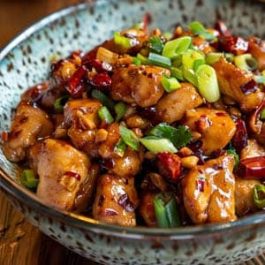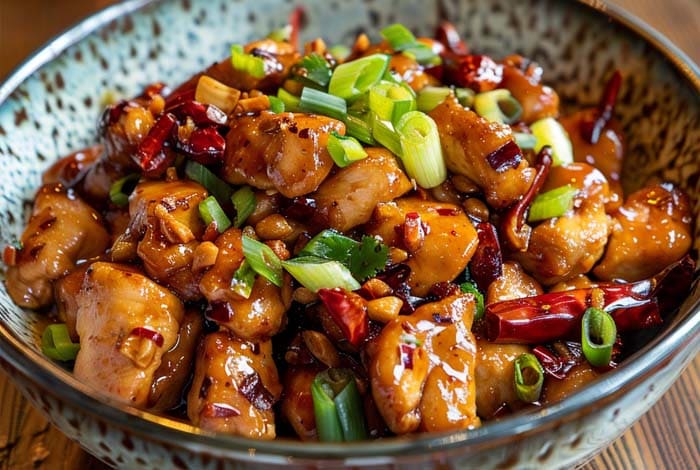Kung Pao Chicken is a globally beloved dish that epitomizes the depth and complexity of Chinese cuisine. Originating from the Sichuan province, known for its bold and spicy flavors, this dish combines the tender texture of chicken with the crunchiness of peanuts and the heat of chili peppers, all enveloped in a rich, savory sauce. The history, cultural significance, and global variations of Kung Pao Chicken reflect its journey from a regional specialty to a worldwide favorite.
Origin and History
The origins of Kung Pao Chicken trace back to the Qing Dynasty, where it was named after Ding Baozhen, a late Qing Dynasty official whose official title was Kung Pao. The dish was initially created in the Sichuan province, a region famed for its love of spicy and bold flavors. The combination of chicken, peanuts, and chili peppers, mixed with the unique flavors of Sichuan peppercorns, created a dish that was both spicy and aromatic, quickly becoming a staple of Sichuan cuisine.
Cultural Significance
Kung Pao Chicken is more than just a dish; it’s a representation of the Sichuan culinary philosophy of balancing heat with flavor. It embodies the Chinese culinary principle of yin and yang—the idea that contrasting flavors and textures can create a harmonious balance. This dish showcases the skillful blend of spiciness, sweetness, and sourness, with each ingredient playing a crucial role in achieving the perfect balance.
Global Variations
As Kung Pao Chicken made its way around the globe, it adapted to local tastes and ingredient availability. In the West, the dish often features a sweeter sauce and less spice, making it more palatable to those unaccustomed to the fiery heat of Sichuan cuisine. Variations might include the addition of vegetables like bell peppers and zucchini, further diversifying its flavor profile.
Understanding the Ingredients
The magic of Kung Pao Chicken lies in its ingredients, each contributing to the dish’s complex flavor and texture.
Main Ingredients Overview
- Chicken: The star of the dish, usually thigh or breast, cut into bite-sized pieces for quick cooking.
- Peanuts: Adds a crunchy texture and nutty flavor, contrasting beautifully with the soft chicken.
- Vegetables: Commonly includes bell peppers and scallions, adding freshness and color to the dish.
Specialty Ingredients for Authentic Flavor
- Sichuan Peppercorns: Offers a unique numbing sensation, a hallmark of Sichuan cuisine.
- Chinese Black Vinegar: Provides a tangy depth, enhancing the overall savoriness.
- Chinese Rice Wine: Adds a subtle sweetness and aroma, elevating the flavors.
- Whole Dried Red Chilies: Introduces a spicy kick, integral to the dish’s signature heat.
Substitutes for Hard-to-Find Ingredients
For those unable to find traditional ingredients, several substitutes can help achieve a similar flavor profile:
- Sichuan Peppercorns: Ground black pepper mixed with a touch of coriander can mimic the numbing effect.
- Chinese Black Vinegar: Balsamic vinegar mixed with a little soy sauce offers a comparable tanginess.
- Chinese Rice Wine: Dry sherry or sake can serve as an adequate replacement.
- Whole Dried Red Chilies: Crushed red pepper flakes or cayenne pepper can provide the necessary heat.
Understanding and sourcing the right ingredients is crucial for recreating the authentic taste of Kung Pao Chicken. Whether sticking to tradition or adapting to local tastes, this dish continues to captivate food lovers around the world with its rich flavors and textures.
Cooking Techniques
Marinating the Chicken
Marinating is a critical step in preparing Kung Pao Chicken. It not only tenderizes the chicken but also infuses it with flavor. A typical marinade includes soy sauce, Chinese Rice Wine, and cornstarch. The soy sauce and wine introduce depth and umami, while the cornstarch helps to seal in the juices, ensuring the chicken remains moist and tender during the high heat of stir-frying.
Stir-Frying Essentials
Stir-frying is a cooking technique that’s central to many Asian cuisines, including Chinese. It involves cooking ingredients quickly over high heat in a small amount of oil, using a wok or a frying pan. The key to successful stir-frying is to have all your ingredients prepped and ready to go before you start cooking, as the process is fast-paced and leaves no time for chopping or measuring.
Balancing Flavors: Spicy, Sweet, and Sour
The essence of Kung Pao Chicken lies in its balance of flavors. The heat from the dried chilies and Sichuan Peppercorns provides the spicy component. Sweetness comes from a bit of sugar added to the sauce, while the sour element is introduced through Chinese Black Vinegar. Adjusting these three components is crucial to achieving the perfect Kung Pao Chicken that caters to your taste preferences.
Step-by-Step Recipe
Preparation of Ingredients
Begin by gathering and preparing your ingredients. Cut the chicken into bite-sized pieces and set aside. Chop the vegetables (bell peppers and scallions) and measure out the peanuts. For the sauce, mix together soy sauce, Chinese Black Vinegar, Chinese Rice Wine, sugar, cornstarch, and water in a bowl.
Marinating Process
In a separate bowl, combine the chicken pieces with a mixture of soy sauce, Chinese Rice Wine, and cornstarch. Let the chicken marinate for at least 15-30 minutes. This process not only flavors the chicken but also tenderizes it, ensuring it cooks to perfection.
Stir-Frying Method
Heat a wok or large frying pan over high heat and add vegetable oil. Once the oil is hot, add the marinated chicken in batches, ensuring not to overcrowd the pan. Stir-fry until the chicken is golden and cooked through, then remove and set aside. In the same pan, add a bit more oil if needed, and stir-fry the vegetables until they’re just tender. Add the dried chilies and Sichuan Peppercorns towards the end to release their flavors without burning them.
Final Touches and Serving Suggestions
Return the chicken to the pan with the vegetables, and pour in the prepared sauce. Stir everything together and cook until the sauce thickens. Finally, stir in the peanuts, giving the dish a final toss to ensure everything is evenly coated with the sauce. Taste and adjust the seasoning, adding more sugar, vinegar, or soy sauce as needed.
Serve your Kung Pao Chicken hot, garnished with sliced scallions. It pairs beautifully with steamed rice or noodles, making for a satisfying meal that’s bursting with flavor. This dish is a testament to the art of balancing flavors and textures, showcasing the depth and diversity of Chinese cuisine.
Nutritional Information
Kung Pao Chicken is a flavorful dish that, while indulgent, can fit into a balanced diet. A typical serving contains approximately 300-400 calories, with a good balance of protein from the chicken, healthy fats from the peanuts, and vitamins from the vegetables. To adapt Kung Pao Chicken for dietary restrictions, gluten-free soy sauce and cornstarch can be used for a gluten-free version, while those with nut allergies can omit the peanuts without compromising the dish’s overall flavor profile.
FAQs
What makes Kung Pao Chicken spicy?
The spiciness in Kung Pao Chicken comes from two key ingredients: dried red chilies and Sichuan Peppercorns. The chilies provide a sharp heat, while the peppercorns add a unique numbing sensation, characteristic of Sichuan cuisine.
Can Kung Pao Chicken be made vegetarian?
Yes, Kung Pao Chicken can easily be adapted for a vegetarian diet by substituting chicken with tofu, tempeh, or a variety of vegetables such as zucchini, mushrooms, and bell peppers. The key flavors of the dish, provided by the sauce and spices, remain deliciously intact.
How to store and reheat leftovers?
Leftover Kung Pao Chicken can be stored in an airtight container in the refrigerator for up to three days. To reheat, simply warm it in a pan over medium heat or in the microwave, adding a little water or broth to loosen the sauce if necessary.
Differences between American and Chinese versions of Kung Pao Chicken?
The American version of Kung Pao Chicken tends to be sweeter and less spicy compared to its Chinese counterpart. It often includes additional vegetables and uses less Sichuan Peppercorns, if any. The authentic Chinese version emphasizes the numbing spiciness of Sichuan Peppercorns and the tanginess of Chinese Black Vinegar, offering a more complex flavor profile.

Kung Pao Chicken Recipe
Equipment
- Wok or large frying pan
- Mixing bowls
- Measuring spoons and cups
- Knife and cutting board
Ingredients
- 1½ lbs chicken breast or thighs cut into bite-sized pieces
- 1 tablespoon soy sauce for marinade
- 1 tablespoon Chinese Rice Wine for marinade
- 2 teaspoons cornstarch for marinade
- ⅓ cup unsalted peanuts
- 2 tablespoons vegetable oil
- 1 red bell pepper diced
- 3 scallions sliced
- 8-10 dried red chilies
- 1 teaspoon Sichuan Peppercorns optional for authentic spiciness
For the Sauce:
- 2 tablespoons soy sauce
- 1 tablespoon Chinese Black Vinegar
- 1 tablespoon Chinese Rice Wine
- 2 teaspoons sugar
- 1 teaspoon cornstarch
- ½ cup water
Instructions
- Marinate the Chicken: In a bowl, combine chicken with soy sauce, Chinese Rice Wine, and cornstarch. Let sit for 15-30 minutes.
- Prepare the Sauce: Mix all sauce ingredients in a separate bowl. Set aside.
- Cook Chicken: Heat 1 tablespoon oil in a wok over high heat. Add chicken in batches, stir-frying until golden. Remove and set aside.
- Stir-Fry Vegetables: Add remaining oil to the wok. Stir-fry bell pepper, scallions, dried chilies, and Sichuan Peppercorns for 2-3 minutes.
- Combine and Cook: Return chicken to the wok. Add the sauce and peanuts. Stir well and cook until the sauce thickens.
- Serve: Garnish with additional scallions and serve hot with steamed rice.
Notes
- For a gluten-free version, use gluten-free soy sauce and ensure all other ingredients are gluten-free.
- To reduce spiciness, adjust the amount of dried chilies and Sichuan Peppercorns according to taste.
- Leftovers can be stored in an airtight container in the refrigerator for up to 3 days and reheated with a splash of water to loosen the sauce.

